After years of relatively little progress on improving housing affordability the Australian Government has declared its commitment to developing a new National Housing and Homelessness Plan, ‘with the support and assistance of key stakeholders including States and Territories, local government, not for profit and civil society organisations, industry bodies, superannuation funds and other experts in housing, finance and urban development.’
Currently Australia doesn’t have a national housing plan; instead, the National Housing and Homelessness Agreement (NHHA)—the most recent in a long history of Commonwealth-State housing agreements—simply exists to articulate the flow of funds from Commonwealth to States/Territories for housing and homelessness programs.
Why have a National Housing and Homelessness Plan
The current NHHA doesn’t impose a wider housing strategy on the Commonwealth Government, merely noting some of the Commonwealth’s responsibilities such as social welfare payments and Commonwealth Rent Assistance (CRA). In reality there are a range of housing market factors not covered in the NHHA that also affect housing, including Commonwealth and state/territory tax settings (including negative gearing and capital gains tax exemptions), financial sector regulation, immigration, state/territory rental subsidies and supports, and state/territory land releases and planning controls.
The state and territory governments are not strategically coordinated to support national objectives, with each jurisdiction having their own specific housing and homelessness concerns and focus. The lack of an overarching national plan over the last few decades has meant Australian housing policy has largely devolved to lower levels of government, with outcomes being reduced coordination, accountability and certainty. As a consequence:
Previous AHURI research has recognised that national plans can benefit specific cohorts of citizens in ways that might not otherwise be the case. Reflecting on the situation in Canada before the recent implementation of its National Housing Strategy (2017), the research identified ‘the value of maintaining Indigenous housing within a national framework. A national policy framework can ensure secure financial arrangements; programs to ensure culturally appropriate housing responses; secure tenancies; self-determination through the establishment of Indigenous controlled housing services’ and that ‘when programs are delivered outside a national framework, they are less likely to be successful.’
The implementation of a National Housing and Homelessness Plan would be expected to identify the complex factors that affect housing and homelessness in Australia and to create the environment in which to develop and instigate policies that will address these problems.
Primarily, an effective National Plan would help to coordinate cooperation between the Commonwealth and the States and Territories Governments, under the direction of the Commonwealth Government but would require fair and honest input and evaluation from the States and Territories. The Plan would need to establish which jurisdiction is responsible for which actions and outcomes, and what are shared responsibilities and how they will best be funded. It would also consider and establish what are the roles and responsibilities for local governments, the community housing sector and other aspects of the housing industry, including finance systems, residential developers and for-profit housing providers.
Developing the Plan will require ‘strong political leadership … ideally leading to longer term and bipartisan positions, supported by bureaucratic expertise.’ All levels of Governments (including local government) will need to consult widely and to agree on what are the Plan’s targets and what are the priorities for action. An ongoing research and evaluation program is vital for making sure the National Plan is always focused on current problems and concerns.
Monitoring of outcomes is essential, so it is important that the data used to understand housing and homelessness outcomes and systems is improved. This includes the reporting mechanisms and data holdings of the Australian Institute of Health and Welfare (e.g., Housing Assistance data, the Australian Government Housing Dataset, and Specialist Homeless Service data), the Australian Bureau of Statistics (e.g., Census of population and housing and the survey of income and housing) and the Productivity Commission’s Report on Government Services (ROGS) data. These datasets, and a range of other data holdings, are vital to the evaluation of the success and progress of any national plan.
AHURI is currently conducting a highly relevant National Housing Research Program project, ‘Towards an Australian Housing and Homelessness Strategy: understanding national approaches in contemporary policy’, that is investigating the rationale for an Australian Housing and Homelessness Plan. Applying contemporary thinking about the role of governments in complex problem-solving, and lessons from other ‘national approaches’ here and internationally, the project will set out the different options for achieving cohesive, co-ordinated action in the Australian federation. The research is anticipated to be available in early 2023.

